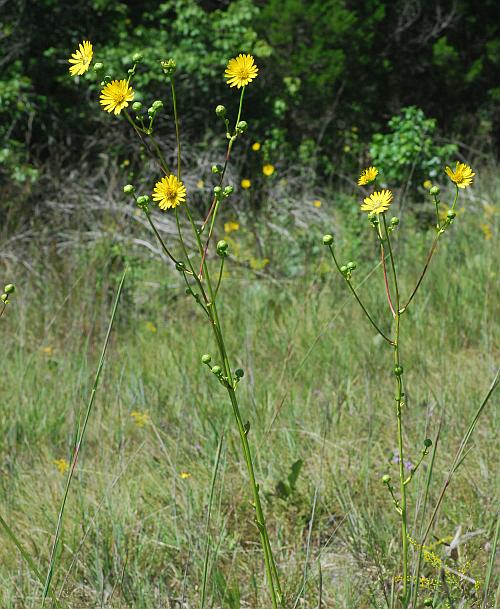Silphium terebinthinaceum Jacq.
Prairie Dock

Native
CC = 5
CW = 0
MOC = 43
© SRTurner
Silphium terebinthinaceum Jacq.Prairie Dock | |
 |
Native CC = 5 CW = 0 MOC = 43 |
© SRTurner |
|
Family - Asteraceae/Heliantheae Habit - Perennial forb with woody taproot. Stem - Ascending to erect, to 2.5 m, usually solitary, usually circular in cross section, smooth, glabrous, sometimes slightly glaucous.
Leaves - Mostly basal, with highly reduced stem leaves alternate. Leaves thick and leathery, usually roughened and pubescent with spreading, strongly pustular-based hairs. Basal leaves simple, long-petiolate, the blade 15-50 cm long, ovate-triangular to nearly circular, usually cordate at the base, pointed at the tip, the margins otherwise coarsely toothed and with minute, appressed hairs. Stem leaves mostly restricted to a few leaves similar to the basal leaves and positioned near the stem base, the median and upper portions of the stem naked or with widely spaced, much-reduced, sessile, bractlike leaves, these 1-3 cm long, sessile, ovate, the base wrapped around the stem, the margins usually entire.
Inflorescence - Loose, open clusters or panicles of heads, these short- to long-stalked or sometimes nearly sessile.
Heads - Involucral bracts 21-35, 13-25 mm long, those of the shorter outer series mostly broadly elliptic, those of the longer inner series oblong-elliptic, usually ascending at the rounded or broadly angled tip, the outer surface glabrous, the margins sometimes with a minute fringe of dense, spreading hairs. Receptacle 1.5-2.5 cm in diameter.
Flowers - Ray florets 13-21, pistillate, the corolla 17-30 mm long, yellow, showy. Disc florets numerous, the corolla 6-7 mm long, slightly shorter than to about as long as the chaffy bracts, 5-lobed, yellow. Style branches with the sterile tip somewhat elongate and tapered. Pappus absent or that of the ray florets of 2 short, triangular, awnlike extensions of the winged angles of the fruit 1-5 mm long (the tip of the fruit then appearing deeply notched), persistent at fruiting.
Fruits - Achenes 7-13 mm long, the surface glabrous or finely hairy, the angles with relatively broad, lighter wings, each wing incurved but abruptly truncate at the tip, the fruit with a U-shaped to semicircular apical notch. Flowering - July - October. Habitat - Glades, upland prairies, tops of bluffs, savannas, openings of dry upland forests, fields, railroads, roadsides. Origin - Native to the U.S. Lookalikes - Vegetatively, Parthenium integrifolium. Other info. - This highly recognizable species occurs in Missouri mostly in the east-central area of the state. It is rare to absent in the northwestern half of the state and the Mississippi Lowlands division. Its North American distribution predominantly occupies a tight band extending diagonally from southwestern Missouri through eastern Michigan, though scattered populations also exist out to the Carolinas and into Canada. Photographs taken at Shaw Nature Reserve, Franklin County, MO, 08-08-2007, Victoria Glade, Jefferson County, MO, 08-25-2015, Little Lost Creek Conservation Area, Warren County, MO, 08-24-2017, and Don Robinson State Park, Jefferson County, MO, 09-01-2018 (SRTurner). |